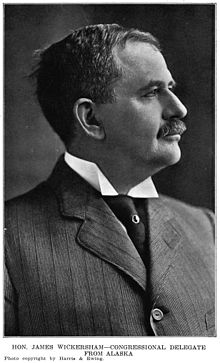This article needs additional citations for verification. (February 2013) |
James Wickersham | |
|---|---|
 | |
| Delegate to the U.S. House of Representatives from Alaska Territory's at-large district | |
| In office March 4, 1931 – March 3, 1933 | |
| Preceded by | Daniel Sutherland |
| Succeeded by | Anthony Dimond |
| In office March 1, 1921 – March 3, 1921 | |
| Preceded by | George Barnes Grigsby |
| Succeeded by | Daniel Sutherland |
| In office January 7, 1919 – March 3, 1919 | |
| Preceded by | Charles August Sulzer |
| Succeeded by | Charles August Sulzer |
| In office March 4, 1909 – March 3, 1917 | |
| Preceded by | Thomas Cale |
| Succeeded by | Charles August Sulzer |
| Personal details | |
| Born | August 24, 1857 Patoka, Illinois, U.S. |
| Died | October 24, 1939 (aged 82) Juneau, Alaska Territory, U.S. |
| Political party | Republican |
| Spouse | Deborah |
| Profession | judge, politician |
| Part of a series on the |
| History of Alaska |
|---|
 |
|


James Wickersham (August 24, 1857 – October 24, 1939) was a district judge for Alaska, appointed by U.S. President William McKinley to the Third Judicial District in 1900.[1] He resigned his post in 1908 and was subsequently elected as Alaska's delegate to Congress, serving until 1917 and then being re-elected in 1930. He was instrumental in the passage of the Organic Act of 1912, which granting Alaska territorial status. He also introduced the Alaska Railroad Bill, legislation to establish McKinley Park, and the first Alaska Statehood Bill in 1916. He was among those responsible for the creation of the Alaska Agricultural College and School of Mines, which later became the University of Alaska. A residence hall on the University of Alaska Fairbanks campus is named in his honor.
Wickersham was born near Patoka, Illinois in August 1857. Many years later, in 1883, he and his wife Deborah moved to Tacoma, Washington Territory, where he became a judge. While in Tacoma he helped lead a mob which forced the city's Chinese population out of town, and was later arrested as one of the "Tacoma Twenty-Seven," though he was never convicted. He was a member of the Tacoma Academy of Science and was President of that organization in 1893. He presented a paper to the Academy on Feb. 6, 1893, entitled, "Is it Mount Tacoma, or Rainier?" During the presentation the following prominent Indians representing the Puyallup, Nesqually and Klickitat tribes were seated on the platform: George Leschi, son of Quiemuth, a leader in the Indian war of 1855; Jack Simmons; John Hiaton, one of the patriarchs of the reservation, 80 years of age, and a signer of the treaty of 1854; Mrs. John Hiaton and John Powers". The presentation has been reproduced by a digital file created at the Library of Congress.[2]
- ^ "James Wickersham | UA Journey". www.alaska.edu. Retrieved 2022-08-05.
- ^ Is it Mount Tacoma, or Rainier? Originally published in Tacoma: News Publishing Company 1893, reproduced by the Library of Congress from a digital file.